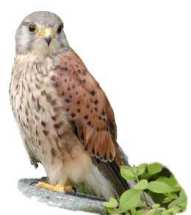|
Photography
|
Kestrel Plate | |||||
|
|
||||||
| Distinguishing Features |  |
|||||
| Height 34cm (13in), Male: grey head and tail, reddish brown back and black bar on the tip of the tail. Female is slightly larger no grey head, tail has a barred pattern with black bar on the tip. | ||||||
| Food | ||||||
| Mainly small mammals; voles, mice. Will also eat insects and other birds like Starlings, Larks | ||||||
| (Falconidae)
falco tinnunculus |
||||||
|
|
||||||
 |
Nesting | |||||
| Between April and June. Clutch of 3 to 5 eggs, white with reddish brown blotches. Incubation appx 28 days. Eggs tended by female, both parents tending the nestlings. | ||||||
| Habitat | ||||||
|
The Kestrel can be found in our cities and towns, is most numerous in areas of rough open grassland. Motorway verges and railway embankments are also favourite places. |
||||||
|
The darker green on the map above indicates
where you are most likely to see a Kestrel.
|
||||||
|
|
||||||
| Other information | ||||||
|
Its more than likely you have seen a Kestrel hovering above the banks of our motorways searching for food. They can be seen gracefully floating on the breeze, or frantically beating there wings to obtain a static position above its hunting ground. Kestrels do not build nests. A depression scratched in a cliff ledge or building, also old bird nests or a tree hollows are suitable sites.
|
 |
|||||
| [Home] [News] [Gallery] [Birds] [Discover] [About] [Contact] [Members] | ||||||